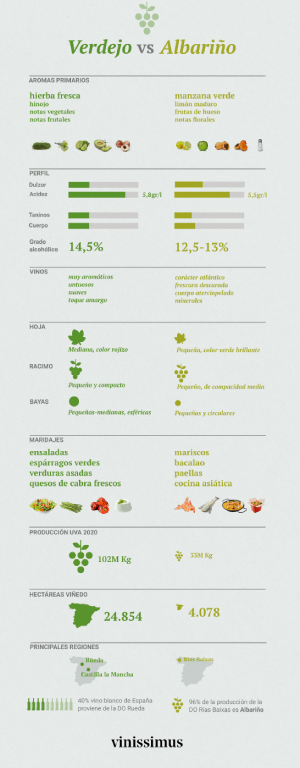Verdejo or Albariño
What are the differences between a Verdejo and an Albariño?


The main differences between a Verdejo and an Albariño can be summarised in two colours. We associate verdejos with green and albariños with a green-yellow colour. It is not that the wines are this colour, but that we associate the sensations they give off with green elements, for example, or with green-white-yellow fruits.
Verdejo wines exhibit herbaceous and vegetal notes; their purest and main attribute is that of fresh grass, hay or freshly cut lawn; in Verdejo wines the fruity notes appear in the background. On the other hand, albariño wines are described first with fruity aromas, with notes of acid fruits such as green apple, ripe lime or lemon, and stone fruits such as apricot or loquats; in albariños, the secondary aromas are floral.
Both verdejos and albariños are wines with good acidity. The acidity of the verdejos is usually gentler while that of the albariños is a tense acidity; and if the minerality of the verdejos is stony, austere, in the albariños it is humid, a saline acidity. The verdejos are characterised by a bitter finish, while the sapidity of the albariños activates the taste pupils and provokes salivation.
Both are very suitable for drinking and aperitifs, but they are also gastronomic. The verdejos are unctuous, fresh and pleasant and pair wonderfully with salads, green asparagus, grilled vegetables and fresh goat's cheese, while the more intense albariños are unbeatable with seafood, fish and paella.
From this point on, an infinite number of factors make one verdejo very different from another, or two albariños from the same winery completely different. Beyond the variety, the personality of each wine also depends to a great extent on the type of soil, the age of the vines, the singularity of some estates, whether it is aged on lees, in wood, cement or clay.
Most of the verdejos and albariños on the market today are young wines. Crianza verdejos and albariños are still very rare, although there are more and more examples that prove the longevity and ageing potential of wines made from these two unique grapes. Verdejo wines fermented or aged in oak barrels are beginning to be numerous and extraordinary. And some albariños with years of bottle ageing are spectacular.
Any examples to check it?
Try to identify a common denominator among the verdejos of Javier Sanz, Marqués de Riscal, Viñedos de Nieva, José Pariente, Naia or Menade, and then compare them with some of the creations of Esmeralda García, Beatriz Herranz, Ismael Gozalo or Isaac Cantalapiedra.
Repeat the experience with the Albariños from Palacio de Fefiñanes, Martín Códax, Zárate, Pazo de Señoráns, Tricó, Gerardo Méndez... and don't forget to add some Leirana from Forjas del Salnés, Pedralonga, Veigamoura or a singular vineyard from Benito Santos. The differences will multiply!